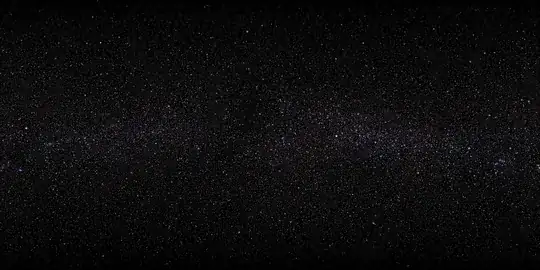"thick purple cluster of gas right in the center". I want to see that.
First off, the human eye is a wonderful device, but it's no match for modern cameras. We can't see colors at such low levels of light. We're all colorblind in those conditions. Only cameras continue to see color when illumination is low.
As a result, when looking at objects such as nebulae or galaxies, including our own, all you see is a black-and-white image. Even with telescopes, the human eye still doesn't see colors in these objects.
There is exactly one single exception - the Orion nebula, which is by far the brightest of all. Some observers, after a bit of practice, can begin to distinguish a few shades of color there.
Planets, and some stars, are different. These objects are much more bright. The human eye has no trouble seeing color where color exists here. E.g. Jupiter is a slight shade of yellow, Betelgeuse is quite clearly red, etc.
purple
I'm pretty sure the Milky Way is not purple. That's probably just a processing artifact. Go on Astrobin and search for "milky way" for a lot more examples - they tend to not look very purple usually.
https://www.astrobin.com/
I want to see this "thick cloud cluster, which I assume is the milky way". How do I see this? How on some days do I only see just stars and stars, when I really want to see this main beauty?
There are two main obstacles to doing astronomy at the bottom of an ocean of air: atmospheric turbulence (a.k.a. "seeing") and light pollution.
Seeing affects observing high resolution objects such as planets and double stars when seen in telescopes. It's caused by air eddies and vortices that muddy the image. It's of no interest here so we can ignore it for this discussion.
Light pollution affects observing faint objects such as galaxies (including our own), nebulae, and star clusters. It's caused by light from artificial sources (city lights, industrial lights, cars, etc) going up, being reflected on particles in the air, then going back down. It makes the sky seem to "glow". It drowns out those objects which are not very bright - and galaxies tend to not be bright.
There's only one way to avoid light pollution: go far away from human settlements and facilities. The desert and the open sea are not light polluted.
Google "light pollution map" for some websites that will help you choose a dark site. Here's one example out of many:
http://www.jshine.net/astronomy/dark_sky/
Recently I've visited Death Valley. The surrounding area has essentially zero light pollution. Even driving 30 minutes out of Ridgecrest you're already under a very dark sky. I took the opportunity to show my kids how a dark sky really looks like.
The Milky Way is very clearly visible. Wherever you look, there are stars upon stars. Take a pair of binoculars, point them at random places in the sky, and even more stars are visible. There are star clusters that you could chance upon just by sweeping the sky with the binoculars, and they look like someone threw a handful of diamonds on black velvet. Little shooting stars are visible often. It's extraordinary.
It should be noted that the Milky Way is not visible during the winter months (December – February). It's best to try to watch it in June – August. Even later in the year (September – November) it's still visible in the West, just before it sets, a short time after nightfall. If you're an early riser, you can see it before daybreak in the spring (March – May).
You need to wait until the sky goes completely dark after sunset. That means 1.5 hours after sunset, or more. To determine the precise moment of sunset, go on Google or Wolfram Alpha and search for "sunset today". Then add 90 minutes to the result.
You will also need to time your visit to a night when the Moon is not visible. The Moon must be below horizon, otherwise it would cause some "light pollution" of its own. A few days before and after the new moon are the best time for this.
You could go on Wolfram Alpha and search for "next new moon" or even "new moon in september" and it will give you the date. Several days plus or minus that date should be fine.
http://www.wolframalpha.com/
TLDR: A moonless night in the summer, in a desert or some other unpopulated area, 1.5 hours after sunset or later.

 I want to see this "thick cloud cluster, which I assume is the milky way". How do I see this? How on some days do I only see just stars and stars, when I really want to see this main beauty?
I want to see this "thick cloud cluster, which I assume is the milky way". How do I see this? How on some days do I only see just stars and stars, when I really want to see this main beauty?